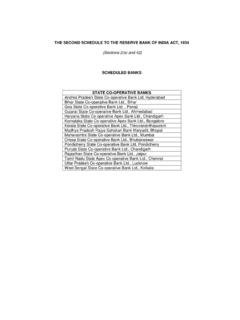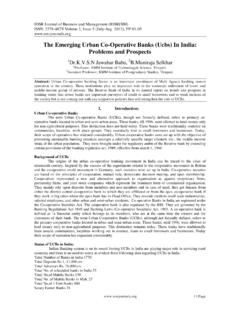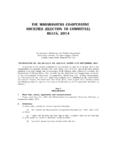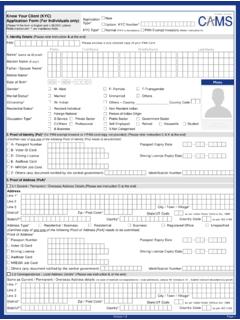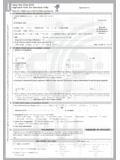Transcription of A study on Cooperative Banks in India with special ...
1 International Journal of Scientific and Research Publications, Volume 2, Issue 10, October 2012 1 ISSN 2250-3153 A study on Cooperative Banks in India with special reference to Lending Practices Jyoti Gupta*, Suman Jain** * MBA, (Economics), New Delhi, India , Faculty: Apar India College of Management and Technology ** MBA, UGC-NET-JRF, New Delhi, India , Faculty: Apar India College of Management and Technology Abstract- Banking business has done wonders for the world economy. The simple looking method of accepting money deposits from savers and then lending the same money to borrowers, banking activity encourages the flow of money to productive use and investments. This in turn allows the economy to grow. In the absence of banking business, savings would sit idle in our homes, the entrepreneurs would not be in a position to raise the money, ordinary people dreaming for a new car or house would not be able to purchase cars or houses.
2 The government of India started the Cooperative movement of India in 1904. Then the government therefore decided to develop the cooperatives as the institutional agency to tackle the problem of usury and rural indebtedness, which has become a curse for population. In such a situation Cooperative Banks operate as a balancing centre. At present there are several Cooperative Banks which are performing multipurpose functions of financial, administrative, supervisory and development in nature of expansion and development of Cooperative credit system. In brief, the Cooperative Banks have to act as a friend, philosopher and guide to entire Cooperative structure. The study is based on some successful co-op Banks in Delhi ( India ).
3 The study of the bank s performance along with the lending practices provided to the customers is herewith undertaken. The customer has taken more than one type of loan from the Banks . Moreover they suggested that the bank should adopt the latest technology of the banking like ATMs, internet / online banking, credit cards etc. so as to bring the bank at par with the private sector Banks . Index Terms- Cooperative movement of India , Usury, Rural Indebtedness, Cooperative Banks , bank s Performance, Lending Practices, Loan, ATMs, Internet/Online Banking, Credit Cards, Private Sector Banks I. INTRODUCTION o-operative Banks are small-sized units organized in the co-operative sector which operate both in urban and non-urban regions. These Banks are traditionally centered on communities, localities and work place groups and they essentially lend to small borrowers and businesses.
4 The term Urban Co-operative Banks (UCBs), though not formally defined, refers to primary Cooperative Banks located in urban and semi-urban areas. These Banks , until 1996, could only lend for non-agricultural purposes. As at end-March 2011, there were 1,645 UCBs operating in the country, of which majority were non-scheduled UCBs. Moreover, while majority of the UCBs were operating within a single State, there were 42 UCBs having operations in more than one State. However, today this limitation is no longer prevalent. While the co-operative Banks in rural areas mainly finance agricultural based activities including farming, cattle, milk, hatchery, personal finance, etc. along with some small scale industries and self-employment driven activities, the co-operative Banks in urban areas mainly finance various categories of people for self-employment, industries, small scale units and home finance.
5 These Banks provide most services such as savings and current accounts, safe deposit lockers, loan or mortgages to private and business customers. For middle class users, for whom a bank is where they can save their money, facilities like Internet banking or phone banking is not very important. Although they are not better than private Banks in terms of facilities provided, their interest rates are definitely competitive. However, unlike private Banks , the documentation process is lengthy if not stringent and getting a loan approved quickly is rather difficult. The criteria for getting a loan from a UCB are less stringent than for a loan from a commercial bank . II. OBJECTIVES OF THE study To know the lending practices of Cooperative Banks in India .
6 To measure and compare the efficiency of Cooperative Banks of India . To study the impact of size on the efficiency of the Cooperative Banks . To suggest the appropriate measures to improve the efficiency of the Cooperative Banks . To know different type of loans preferred by different sets of customers. To know the satisfaction level of the customers from bank s lending policies. III. REVIEW OF THE LITERATURE Various studies conducted and numerous suggestions were sought to bring effectiveness in the working and operations of financial institutions. Narsimham Committee (1991) emphasized on capital adequacy and liquidity, Padamanabhan Committee (1995) suggested CAMEL rating (in the form of ratios) to evaluate financial and operational efficiency, Tarapore Committee (1997) talked about Non-performing assets and asset quality, Kannan Committee (1998) opined about working capital and lending methods, Basel committee (1998 and revised in 2001) recommended capital adequacy norms and risk C International Journal of Scientific and Research Publications, Volume 2, Issue 10, October 2012 2 ISSN 2250-3153 management measures.
7 Kapoor Committee (1998) recommended for credit delivery system and credit guarantee and Verma Committee (1999) recommended seven parameters (ratios) to judge financial performance and several other committees constituted by Reserve bank of India to bring reforms in the banking sector by emphasizing on the improvement in the financial health of the Banks . Experts suggested various tools and techniques for effective analysis and interpretation of the financial and operational aspects of the financial institutions specifically Banks . These have focus on the analysis of financial viability and credit worthiness of money lending institutions with a view to predict corporate failures and incipient incidence of bankruptcy among these institutions.
8 Bhaskaran and Josh (2000) concluded that the recovery performance of co-operative credit institutions continues to unsatisfactory which contributes to the growth of NPA even after the introduction of prudential regulations. They suggested legislative and policy prescriptions to make co-operative credit institutions more efficient, productive and profitable organization in tune with competitive commercial banking. Jain (2001) has done a comparative performance analysis of District Central Co-operative Banks (DCCBs) of Western India , namely Maharashtra, Gujarat and Rajasthan and found that DCCBs of Rajasthan have performed better in profitability and liquidity as compared to Gujarat and Maharashtra. Singh and Singh (2006) studied the funds management in the District Central Co-operative Banks (DCCBs) of Punjab with specific reference to the analysis of financial margin.
9 It noted that a higher proportion of own funds and the recovery concerns have resulted in the increased margin of the Central Co-operative Banks and thus had a larger provision for non-performing assets. Mavaluri, Boppana and Nagarjuna (2006) suggested that performance of banking in terms of profitability, productivity, asset quality and financial management has become important to stable the economy. They found that public sector Banks have been more efficient than other Banks operating in India . Pal and Malik (2007) investigated the differences in the financial characteristics of 74 (public, private and foreign) Banks in India based on factors, such as profitability, liquidity, risk and efficiency. It is suggested that foreign Banks were better performers, as compared to other two categories of Banks , in general and in terms of utilization of resources in particular.
10 Campbell (2007) focused on the relationship between nonperforming loans (NPLs) and bank failure and argued for an effective bank insolvency law for the prevention and control of NPLs for developing and transitional economies as these have been suffering severe problems due to NPLs. Singla(2008) emphasized on financial management and examined the financial position of sixteen Banks by considering profitability, capital adequacy, debt-equity and NPA. Dutta and Basak (2008) suggested that Co-operative Banks should improve their recovery performance, adopt new system of computerized monitoring of loans, implement proper prudential norms and organize regular workshops to sustain in the competitive banking environment. Chander and Chandel (2010) analyzed the financial efficiency and viability of HARCO bank and found poor performance of the bank on capital adequacy, liquidity, earning quality and the management efficiency parameters.










